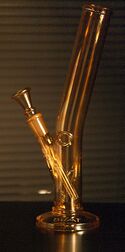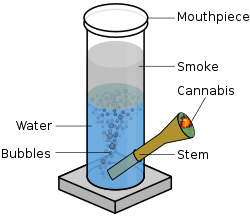Medicine:Bong
A bong (also known as a water pipe) is a filtration device generally used for smoking cannabis, tobacco, or other herbal substances.[1] In the bong shown in the photo, the smoke flows from the lower port on the left to the upper port on the right.
In construction and function, a bong is similar to a hookah, except smaller and especially more portable. A bong may be constructed from any air- and water-tight vessel by adding a bowl and stem apparatus (or slide)[2] which guides air downward to below water level whence it bubbles upward ("bubbler") during use. To get fresh air into the bong and harvest the last remaining smoke, a hole known as the "carburetor", "carb", "choke", "bink", "rush", "shotty", "kick hole", or simply "hole", somewhere on the lower part of the bong above water level, is first kept covered during the smoking process, then opened to allow the smoke to be drawn into the respiratory system. On bongs without such a hole, the bowl and/or the stem are removed to allow air from the hole that holds the stem.
Bongs have been in use by the Hmong in Laos and Thailand, as well all over Africa, for centuries.[3] One of the earliest recorded uses of the word in the West is in the McFarland Thai-English Dictionary, published in 1944, which describes one of the meanings of bong in the Thai language as, "a bamboo waterpipe for smoking kancha, tree, hashish, or the hemp-plant". A January 1971 issue of the Marijuana Review also used the term.
Etymology
The word bong is an adaptation of the Thai word bong or baung (Thai: บ้อง, [bɔ̂ŋ]), which refers to a cylindrical wooden tube, pipe, or container cut from bamboo, and which also refers to the bong used for smoking.
History
Excavations of a kurgan in Russia in 2013 revealed that Scythian tribal chiefs used gold vessels 2400 years ago to smoke cannabis and opium. The kurgan was discovered when construction workers were clearing land for the construction of a power line.[4]
During the reign of Emperor Akbar, physician Hakim Abul Fath invented the waterpipe in India , and discovered tobacco. Abul suggested that tobacco "smoke should be first passed through a small receptacle of water so that it would be rendered harmless".[5] Other sources also show evidence of the invention of the waterpipe in China during the late Ming dynasty (16th century), along with tobacco, through Persia and the Silk Road.[citation needed] By the Qing dynasty, it became the most popular method to smoke tobacco, but became less popular since the Republic era. While typically employed by commoners, the water pipe is known to have been preferred by Empress Dowager Cixi over snuff bottles or other methods of intake. According to the Imperial Household Department, she was buried with at least three water pipes; some of her collections can be seen in the Palace Museum.
The water pipe employed since the Qing dynasty can be divided into two types: the homemade bamboo bong commonly made and used by country people, and a more elegant metal version employed by Chinese merchants, urbanites, and nobility. Metal utensils are typically made out of bronze or brass, the nobility version of silver and decorated with jewels. Typically, the metal version is made out of the following components:
- The water pipe itself, a single-piece construct consisting of the bowl-stem, the water container, and a drawtube at least 3 inches, but some can be up to 12 inches in length. Some are straight with a "Joint" (Sandblasted top part of stem, usually about 1 inch long, and all the way around, tapered or cone shaped, so the tapered, or "cone shaped" bowl will fit in)some are bent to resemble a crane. The size of the bowl is similar to that of a one-hitter, typically the width of a thumbnail or smaller.
- The tobacco container with a lid.
- A pipe rack small enough to be held by one hand, and consisting of two large holes for the tobacco container and the water pipe. It may have smaller holes to hold various pipe tools.
During a smoking session, the user may keep all equipment inside the rack and just hold the entire assembly (rack, pipe, and container) in one hand, lighting the bowl with a slow-burning paper wick (纸煤) lit over a coal stove. Unlike in North America and the Southern Hemisphere, the water pipe is typically employed by older generations.[citation needed]
Use
The water can trap some heavier particles and water-soluble molecules, preventing them from entering the smoker's airways.[6] The mechanics of a bong are compared to those of a laboratory gas washing bottle. The user puts their mouth at the top and places the cannabis in the tube, as shown in the picture.
Bongs are often either glass or plastic that use a bowl, stem, and water to produce smoke. Most glass bongs are made from heat resistant borosilicate glass, allowing the bong to withstand repeated use and heat exposure without breaking. After the bowl has been packed and water has been inserted into the bong, the substance is lit and the smoke is drawn through water to produce a smoother smoke than other methods of smoking do.[7] To smoke a bong, the smoker must inhale in the bong so bubbles containing smoke begin to come from the stem. Once the bong has a fair amount of smoke built up, either the carb is uncovered or the stem is separated from the bong, allowing the remaining smoke to be inhaled.
However, a 2000 NORML-MAPS cannabis study found that "water pipes filter out more psychoactive THC than they do other tars, thereby requiring users to smoke more to reach their desired effect".[8] In the study, smoke from cannabis supplied by the NIDA was drawn through a number of smoking devices and analyzed. This study looked at the tar to cannabinoid ratio in the gas in output by various bongs, as well as unfiltered and filtered joints, and vaporizers. The results showed that only vaporizers produced a better tar to cannabinoid ratio than unfiltered joints, but that within the cannabinoids produced, even vaporizers warped the ratio of THC (the psychoactive component of the smoke) to CBN (capable of producing medical benefits but is not psychoactive) in favor of CBN. This showed an unfiltered joint had the best tar to THC ratio of all, and bongs were actually seriously detrimental in this respect.
MAPS[9] also reviewed a study that examined the effects and composition of water-filtered and non-filtered cannabis and tobacco smoke. It found that when alveolar macrophages were exposed to unfiltered smoke, their ability to fight bacteria was reduced, unlike exposure to water-filtered smoke. It also found substantial epidemiological evidence of a lower incidence of carcinoma among tobacco smokers who used water-pipes, as opposed to cigarettes, cigars, and regular pipes. "It appears that water filtration can be effective in removing components from cannabis smoke that are known toxicants... The effectiveness of toxicant removal is related to the smoke's water contact area."
Specially designed water pipes, incorporating particulate filters and gas-dispersion frits, would likely be most effective in this regard; the gas-dispersion frit serves to break up the smoke into very fine bubbles, thereby increasing its water-contact area.[9] These frits are commonly referred to as diffuser for the way that they diffuse (or disperse) the smoke as it exits the downstem, and usually consist of small holes or slats at the end of the downstem. This study suggests that a bong's smoke is less harmful than unfiltered smoke.
Adverse health effects
Bongs that are cleaned regularly eliminates yeast, fungi, bacteria and pathogens that can cause several symptoms that vary from allergy to lung infection.[10]
Plastic bongs
It has been reported that it is possible to taste the chemicals in the water from a plastic water bottle left sitting in a hot car because "...chemicals have leached into the contents of the bottle."[11] It was also reported that it is possible to imagine that this process of chemicals leaching into water occurring with "...a homemade water bottle bong where the bottle is routinely heated up."[11]
It was also reported that "According to Cancer Research UK, plastic bottles heated up to 60°C contain unhealthy levels of toxic chemicals."[11]
Legal issues
In the United States , under the Federal Drug Paraphernalia Statute, which is part of the Controlled Substances Act, it is illegal to sell, transport through the mail, transport across state lines, import, or export drug paraphernalia.[12]
In countries where marijuana and hashish are illegal, some retailers specify that bongs are intended for use with tobacco in an attempt to circumvent laws against selling drug paraphernalia. While technically "bong" does not mean a device used for smoking mainly cannabis, drug-related connotations have been formed with the word itself (partly due to punning with Sanskrit bhangah "hemp"). Thus for fear of the law many head shops will not serve customers who use the word "bong" or "bongs", or any other word typically associated with illegal drug use.[13]
Some brand name bong manufacturers (notably RooR) have sought to curb the counterfeit market for their products by suing stores accused of selling fake merchandise.[14]
See also
- Drug paraphernalia
- Hookah
- One-hitter (smoking)
- Gravity bong
- Operation Pipe Dreams
- Thuoc lao
- Vaporizer (inhalation device)
References
- ↑ "Contraband: The Sale of Regulated Goods on the Internet". http://ul451.gsu.edu/lawand/papers/fa05/albright_shawkat_susor/.
- ↑ Delaney, Arthur (2008-05-09). "How To Make a Skull Bong" (in en-US). Slate. ISSN 1091-2339. https://slate.com/news-and-politics/2008/05/can-a-human-skull-be-used-as-a-bong.html.
- ↑ "The real history of the bong". 5 February 2008. https://www.420magazine.com/community/threads/the-real-history-of-the-bong.73197/.
- ↑ National Geographic (22 May 2015). "Gold Artifacts Tell Tale of Drug-Fueled Rituals and "Bastard Wars"" (in en-US). https://www.nationalgeographic.com/adventure/article/150522-scythians-marijuana-bastard-wars-kurgan-archaeology.
- ↑ "Waterpipe Overview – WHO FCTC Secretariat's Knowledge Hub on waterpipes" (in en-US). https://untobaccocontrol.org/kh/waterpipes/waterpipe-overview/.
- ↑ "Marijuana Consumption: Smoking, Eating, And Drinking Marijuana". http://www.premiumbongs.com/bong-information.html.
- ↑ Keliher, Evan (2003). Grandpa's Marijuana Handbook (2nd ed.). Chula Vista, California: Aventine Press. p. 37. ISBN 978-1-59330-135-4.
- ↑ "MAPS - Volume 6 Number 3 Summer 1996 -". https://maps.org/news-letters/v06n3/06359mj1.html.
- ↑ 9.0 9.1 Cozzi, Nicholas V.. "Effects of water filtration on marijuana smoke: a literature review". https://www.ukcia.org/research/EffectsOfWaterFiltrationOnMarijuanaSmoke.php.
- ↑ The Dangers of a Dirty Bong, 16 July 2018, https://www.leafscience.com/2018/07/16/dangers-dirty-bong/, retrieved 21 December 2022
- ↑ 11.0 11.1 11.2 Powell, Burgess (2014). "The Dangers of Smoking Out of Plastic". High Times. https://hightimes.com/health/dangers-smoking-plastic/.
- ↑ "DEA Definition of Paraphernalia - gas mask bong, Squeeze bottle filled with GHB...". http://headshops.us/dea-definition-of-Paraphemalia.html.
- ↑ "Phoenix New Times: Head Games". http://www.phoenixnewtimes.com/2006-02-16/news/head-games/.
- ↑ Spencer, Terry (23 January 2017). "Pipe maker sues: Fake bongs hit world of high-end glass pipes". Thecannabist.co. http://www.thecannabist.co/2017/01/23/bongs-bogus-lawsuit-counterfeits/71915/.
Further reading
- Erika Dugas, Michèle Tremblay, Nancy C.P. Low, Daniel Cournoyer, Jennifer O'Loughlin: Water-Pipe Smoking Among North American Youths, Pediatrics, Published online May 10, 2010, doi:10.1542/peds.2009-2335 (Full Text free)
External links
- Erickson, William V. et al. Water pipe or bong. US Patent 4,216,785.
- 2400-year-old Scythian bongs excavated
 |






